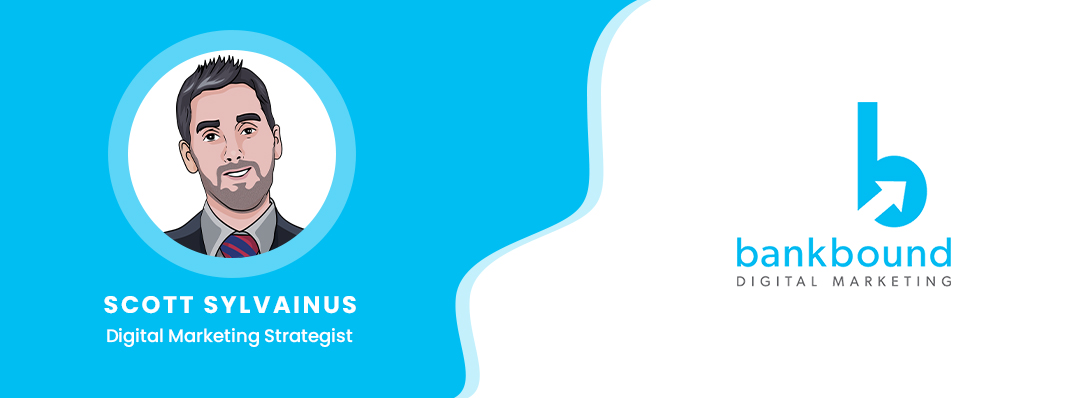Bank Marketing Strategy
In the competitive banking landscape, a strong digital presence is crucial. SEO is not merely a trend but a vital tool, and accurately measuring its success can be challenging. Be cautious of those offering instant or guaranteed results in SEO for financial institutions, as true SEO, particularly in banking, demands both time and expertise. BankBound is attuned to the specific challenges and opportunities in the financial sector, ensuring our SEO strategies for banks are always aligned with industry changes and customer needs.

Setting Clear SEO Objectives and Goals
Knowing where you stand today will help measure the impact of your SEO efforts tomorrow. Establish baselines like your current website traffic, average keyword rankings, or conversion rates. These baselines act as a reference point, allowing you to track progress, celebrate successes, and recalibrate strategies when needed.
Aligning your SEO goals with your business objectives is essential for digital success. This alignment involves differentiating between short-term goals, such as a spike in website traffic or increased sign-ups, and long-term objectives like sustained organic growth, consistent top keyword rankings, or becoming the region’s go-to source for financial advice and products.
Some example situations might be
- Expanding into New Areas: If your bank is venturing into a new region or demographic, SEO can play a pivotal role in building brand awareness and trust. It’s not just about being seen; it’s about being recognized as a reliable financial partner in that area.
- Growing the Customer Base: Perhaps you’re looking to increase your account holders. In this case, your SEO strategy should target keywords and content that potential customers might search for, such as “best savings accounts” or “reliable banks near me”.
- Introducing a New Product: Launching a new financial product or service? Specialized SEO for financial institutions can help highlight its features and benefits, targeting searches like “innovative banking solutions” or “digital banking services”.

Key User Engagement Metrics to Measure SEO Success
In the banking industry, where trust and credibility are paramount, understanding and analyzing SEO metrics can provide invaluable insights into your digital strategy’s effectiveness. By understanding these metrics in-depth, banks can refine their SEO strategies, ensuring they resonate with potential customers.
Let’s delve deeper into some of these metrics:
Organic Traffic
- What is it?: The number of visitors who come to your site directly from search engines without the influence of paid ads.
- Why measure it?: A consistent rise in organic traffic indicates that your content is relevant, trustworthy, and aligns with what potential customers are searching for.
- Success Indicators: A steady increase suggests growing trust in your bank’s digital presence and effective SEO efforts.
- Red Flags: A sudden drop might indicate technical issues, penalties, or that competitors are outperforming you in content relevance.
Keyword Rankings:
- What is it?: The position your website appears in search engine results for specific keywords or phrases.
- Why measure it?: It helps understand which terms related to banking and financial services are driving traffic to your site.
- Success Indicators: Terms like “online banking in [your city]” or “best mortgage rates near me” leading users to your site indicate effective keyword targeting.
- Red Flags: If targeted keywords aren’t driving traffic, it might be time to reevaluate your content or understand why certain keywords are underperforming.
SERP (Search Engine Results Page) Metrics:
- What is it?: Data related to how often your site appears in search results (impressions), how many users click on your site from the results (clicks), and your average position.
- Why measure it?: It provides insights into your website’s visibility and appeal in search results.
- Success Indicators: High impressions coupled with a good click-through rate suggest your meta descriptions and content snippets are compelling.
- Red Flags: High impressions but low clicks might indicate unappealing meta descriptions. Consistently ranking below competitors suggests the need to enhance your content strategy or secure more authoritative backlinks.
Engagement Rate:
- What is it?: The percentage of visitors who engaged with your page with a click, spending time on the page, or completing an conversion action..
- Why measure it?: It can indicate whether your landing pages are resonating with visitors and providing the information they seek.
- Success Indicators: A low bounce rate suggests visitors find your content valuable and are exploring more of what your bank offers.
- Red Flags: A high bounce rate might indicate that users aren’t finding what they’re looking for, there are technical issues, or the page content isn’t compelling enough.

Conversion Actions That Indicate SEO Success
By closely monitoring conversion actions, banks can gain insights into their digital strategy’s effectiveness; they’re indicators of trust, credibility, and the effectiveness. Let’s delve deeper into these conversion actions:
Lead Generation:
- What is it?: Actions taken by potential customers to express interest, such as filling out forms, signing up for newsletters, making contact requests, or initiating phone calls.
- Why is it important?: These actions signify that users trust your bank enough to share personal information or seek further engagement.
- Success Indicators: A steady flow of inquiries about loan rates, consistent sign-ups for financial tips newsletters, or frequent requests for callbacks.
- Red Flags: If these metrics are dwindling, it might indicate that your call-to-action elements aren’t compelling, or your content isn’t resonating with potential customers.
Engagement Metrics:
- What are they?: Metrics that measure user interaction with your site, such as time spent on site, pages per session, and social shares.
- Why are they important?: They indicate how valuable and engaging users find your content.
- Success Indicators: Users spending significant time reading articles, exploring various services, or sharing your content on social media.
- Red Flags: Low time spent on site or few pages per session might suggest that users aren’t finding the information they seek or that the content isn’t engaging.

How SEO Amplifies Content, Social Media, PPC and Email Campaigns
Each of these channels—content, social media, PPC, and email—has its unique strengths, it’s the power of SEO that can truly amplify their results, creating a cohesive and effective digital marketing strategy for banks.
Blog Content:
For blog content, a well-executed SEO strategy ensures that the material is not only high-quality but also discoverable. By optimizing blog content with relevant keywords and ensuring it answers the queries of potential customers, banks can ensure their articles, blogs, and guides rank higher in search results. This not only drives organic traffic but also positions the bank as an authoritative voice in the financial sector.
Paid Ads:
For PPC (Pay-Per-Click) campaigns, understanding which keywords resonate with their audience through organic search, banks can craft more effective and targeted ad campaigns. Furthermore, directing this paid traffic to high-quality product specific landing pages is crucial. A well-optimized landing page, tailored to the audience’s needs and expectations, ensures better user engagement. When visitors are met with relevant information and a seamless user experience, it naturally leads to higher conversions. This combined approach not only ensures a higher click-through rate but also maximizes conversions, thereby optimizing the return on ad spend.
Email Marketing
In email marketing, SEO insights can be leveraged to tailor content that resonates with the audience. By understanding what potential customers are searching for, banks can craft email content that addresses these queries, leading to higher open rates and engagement. Furthermore, embedding SEO-optimized links within these emails can drive recipients back to the bank’s website, creating a seamless integration between email marketing and organic search efforts.
Social Media:
When it comes to social media, SEO plays a subtle yet impactful role. Sharing SEO-optimized content on platforms like Facebook, Twitter, or LinkedIn can increase its reach. As users engage with and share this content, it can drive more traffic back to the bank’s website, further boosting its search engine rankings.

Challenges in Measuring SEO Success
While the challenges in measuring SEO success are real, they’re not insurmountable. With patience, adaptability, and a commitment to continuous learning, banks can navigate these challenges and harness the full power of SEO.
Managing expectations:
It’s crucial to recognize that SEO is a marathon, not a sprint. Unlike some digital strategies that might yield immediate results, SEO requires patience and persistence. Even with the most meticulously crafted strategies, it can take months before tangible results manifest. This long-term nature can sometimes be discouraging. The wait is often worth it, as the benefits of a well-executed SEO strategy can be long-lasting and profound.
Evolving Algorithms:
Search engines, especially giants like Google, frequently update their algorithms to provide users with the most relevant and high-quality results. Just when you think you’ve got a handle on it, the rules change. For banks and financial institutions, this means continuously staying updated and being ready to pivot strategies when necessary.
Audit and Adapt:
The digital landscape, customer behaviors, and industry trends are in constant flux. What worked a year ago might not be as effective today. Therefore, it’s beneficial to revisit and assess the metrics and conversion actions discussed throughout this article. An audit can shed light on areas of improvement, ensuring that the SEO strategy remains aligned with the bank’s objectives and the ever-changing digital environment.

Unlock Your Website's Power: Partner with BankBound Today!
In the fast-paced world of digital marketing, setting clear SEO goals and measuring them accurately is key. As the digital landscape evolves, we need to adapt and adjust our aim constantly. Eager to tackle your organization’s website SEO? Join us, stay in the loop, and let’s achieve digital greatness with BankBound.


